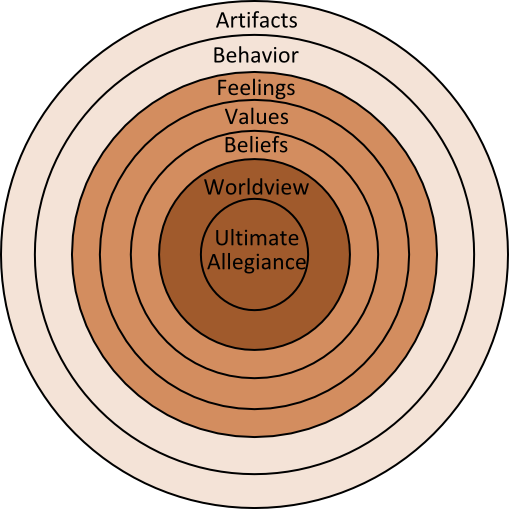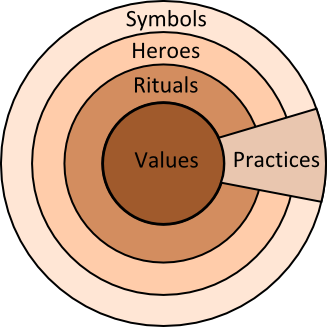This post is about culture learning. Aside from linguists, most people study language to get at the underlying culture. LCP wants to support culture learning as much as we can—our new name reflects that desire (Language & Culture Programme, rather than just Language Orientation Program).
How can we learn more about Afghan culture? There are lots of ways; you can google “ethnographic field methods” if you need some concrete suggestions and methods. The Exploring Culture web site also gives a lot of concrete activities. Let’s take a step back though, and think about culture quite generally. I found two “onion” diagrams about culture online, which I’ll share here.
The Bunkowske diagram offers seven layers of culture, in three groups: the actualizing level (lightest), the evaluating level (medium), and the foundational level (darkest).
The outer shells of culture are artifacts (i.e., things people make) and behavior. The artifacts of Afghan culture are in the outermost layer for two reasons. First, they are there for everybody to see. Second, they depend on the next layer in: behavior. So you can read this diagram several ways:
- Artifacts depend on Behavior, which depends on Feelings, which depends on Values, which depend on Beliefs, which depend on Worldview, which depend on Ultimate Allegiance.
- It is easier to get information about Artifacts than about Behavior, which is easier to get information about than Feelings, Values, Beliefs, Worldview, and Ultimate Allegiance (in that order).
- Ultimate Allegiance determines Worldview, which determines Beliefs, which determine Values, which determine Feelings, which determine Behavior, which depend on Artifacts.
The shape of the diagram implies (to me) that one has to burrow through the outer layers to get to the inner layers. I think there’s something to that. It is easy to observe the artifacts and behaviors relating to naan in Afghanistan, for example. It’s harder to come to grips with how people feel about naan: the respect they show it at meals, why it can never be thrown away, etc. It’s harder still to understand the connections to the deepest beliefs, which perhaps related to faith in the providence of God, for example.
This diagram challenges me to think about how deeply I have gone in Afghan culture. I’m not doing too badly on Artifacts and (most) Behavior. But how much do I trust my intuitions about Feelings, Values, and Beliefs? I’m on much shakier ground there.
The Hofstede diagram takes a more conceptual approach, encouraging us to look at symbols, heroes, rituals, and values.
I call this diagram “conceptual” because the relations are logical. Values may determine rituals, but it’s a lot easier to observe rituals than values! I also like the inclusion of Heroes as an explicit category. As I was recently reading Dari schoolbooks, I was impressed by the selection of heroes: how people are commended and for what.
I also like that in this diagram, Practices (i.e., Behavior) cuts through the diagram. Occasionally we have an experience that gives us a deep insight into the culture. An offhand remark, or an emotional reaction, gives us the angle we need to understand something, “Ah, so that’s what this was all about.”
Where are you in your cultural learning? What would you like to know more about, and how can you get where you want to go? Surely the answer will involve talking to people. Some of the links above can give you concrete ways to start.

